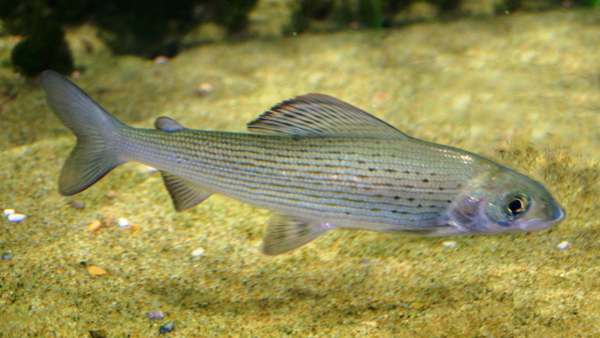Thymallus thymallus - Grayling
Phylum: Chordata - Class: Actinopterygii - Order: Salmoniformes - Family: Salmonidae

The grayling is an unusual fish. Its adipose fin - the little rubbery one just forward of the tail - identifies it as a game fish, and yet it insists on spawning in the spring and early summer, as the coarse fish do. The scientific name comes from a reputed herb-like smell associated with grayling; to most people, however, they smell like fish!
The British rod-caught record grayling was caught in 2009 by Paul Mildren while fishing on the River Frome, in Dorset; it weighed a hefty 4lb 4.5oz (1.9kg).

Grayling are not native to Welsh rivers, but where they have been introduced they tend to do very well. The Welsh Dee, the Wye and the Severn are all noted grayling rivers in their middle and upper reaches.
Grayling to nearly 4lb (1.8kg) have been caught in recent years from the Wye, while the Welsh Dee is rated as one of the finest grayling rivers in Europe. In recent years, as salmon stocks have declined, grayling appear to have found the Welsh rivers ever more to their liking. Fish of over 2.5 lb (1.1 kg) are now very common.

Even some of the South Wales Valleys rivers - the Taff and Ogmore, for example - can now provide exceptionally good grayling fishing. The best time is from late August until the end of January.
With the exception of a small stretch of the River Teifi, near Llanybydder, there are no grayling in the West Wales rivers, and neither are there any in Gwynedd.
Acknowledgements
This page includes pictures kindly contributed by Dr Nick Giles.
Excited at the prospect of flyfishing? So are we, and we're pretty sure you would find the Winding River Mystery trilogy of action-packed thrillers gripping reading too. Dead Drift, Dead Cert, and Dead End are Pat O'Reilly's latest river-and-flyfishing based novels, and now they are available in ebook format. Full details on our website here...
Buy each book for just £4.96 on Amazon...
Please Help Us: If you have found this information interesting and useful, please consider helping to keep First Nature online by making a small donation towards the web hosting and internet costs.
Any donations over and above the essential running costs will help support the conservation work of Plantlife, the Rivers Trust and charitable botanic gardens - as do author royalties and publisher proceeds from books by Pat and Sue.
